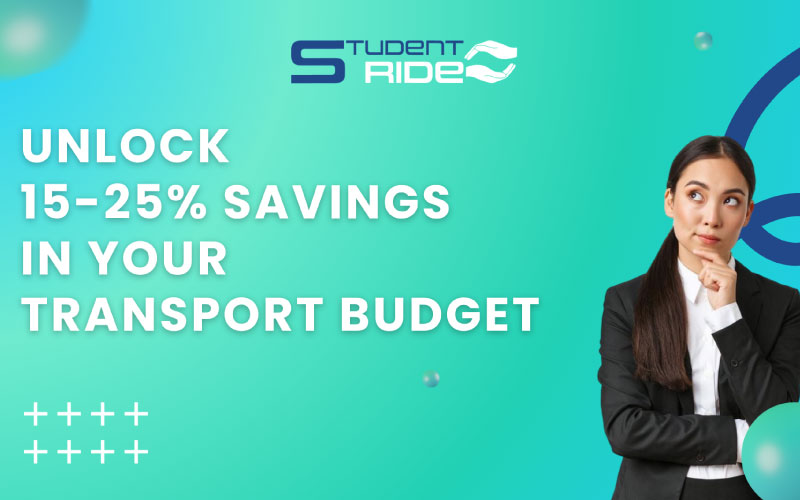Why Transport Budgets Are Under Pressure
Independent schools across Australia are facing the squeeze. Rising operational costs, higher expectations from parents, and stricter compliance requirements mean transport budgets are under immense strain. For school leaders, the challenge isn’t just cutting costs—it’s finding smarter ways to deliver safe, reliable, and efficient transport services without compromising quality.
The good news? Schools can achieve 15-25% savings by embracing technology, improving efficiency, and rethinking outdated systems. This article explores where the money goes, what inefficiencies drain resources, and how platforms like StudentRide help schools unlock measurable savings.
The True Cost of School Transport
Fuel and Maintenance Expenses
Fuel remains one of the biggest ongoing costs for school transport. Rising prices add unpredictability to budgets. Maintenance and repairs, particularly for older fleets, further drive up expenses.
Driver Wages and Compliance Costs
Schools must ensure drivers are paid fairly while meeting compliance requirements such as Working With Children Checks, ongoing training, and record-keeping. These obligations, while necessary, add significant costs.
Insurance and Liability Cover
Independent schools often pay higher insurance premiums because of liability risks. Comprehensive cover is essential, but inefficiencies can inflate premiums.

Hidden Inefficiencies Eating into Your Budget
Underutilised Buses and Empty Seats
Running half-full buses wastes fuel, driver time, and vehicle wear. Without accurate passenger data, schools risk overspending.
Inefficient Route Planning
Old-fashioned manual route planning often results in longer trips, more kilometres, and unnecessary costs.
Manual Admin and Reporting
Staff hours spent coordinating schedules, communicating with parents, and preparing compliance reports can quickly add up.
Smarter Strategies to Unlock up to 15-25% Savings
Route Optimisation Using AI
AI-driven routing analyses real-time traffic and student addresses to reduce kilometres and fuel spend. Smarter routes mean faster journeys and lower costs.
Consolidating Services Across Schools
Independent schools in the same area can consolidate routes, sharing services and maximising seat usage.
Digitising Admin and Parent Communication
Replacing manual calls and paperwork with apps reduces staff hours. Parent portals streamline communication, freeing up valuable admin resources.
The Role of Technology in Cost Reduction
Real-Time Tracking for Accountability
Live GPS tracking ensures buses are where they should be, reducing delays and parent concerns while optimising efficiency.
Automated Scheduling and Compliance Logs
Digital systems handle driver rosters, student check-ins, and compliance reporting automatically, saving schools dozens of staff hours each term.
Parent Portals for Transparency
Instead of admin teams fielding calls, parents access live updates through portals and apps—reducing workload and improving satisfaction.
Case Study: How One Independent School Achieved 20% Savings
The Problem Before Change
A Melbourne-based independent school was struggling with rising costs, underutilised buses, and frequent parent complaints about communication.
Solutions Implemented
- Introduced AI-powered route planning
- Adopted RFID student check-in for accurate tracking
- Launched a parent portal with real-time updates
Results: Cost Reduction and Improved Parent Trust
- 20% budget savings in the first year
- 50% reduction in admin time spent on transport coordination
- Improved parent satisfaction scores by 30%
Environmental Benefits of Smarter Spending
Fewer Kilometres Driven, Lower Emissions
Optimised routing reduces fuel consumption, cutting both costs and carbon emissions.
Supporting School Sustainability Targets
Schools can align transport savings with sustainability goals, showing commitment to environmental leadership.
Overcoming Resistance: Common Objections from Leaders
“It Costs Too Much to Implement”
The reality: upfront investments are outweighed by long-term savings in fuel, wages, and admin efficiency.
“Parents Won’t Accept Change”
With real-time updates and increased safety, parents overwhelmingly prefer smarter systems once in place.
“Staff Don’t Have Time for New Systems”
Platforms like StudentRide provide onboarding support and intuitive interfaces, making adoption smooth.
FAQs About School Transport Savings
Q1: How can schools realistically save 15-25%?
By cutting fuel, reducing admin workload, and optimising bus capacity.
Q2: Will smarter systems increase staff workload?
No—digital tools reduce repetitive admin tasks, freeing staff time.
Q3: What’s the biggest source of waste in school transport?
Inefficient routes and half-empty buses.
Q4: How quickly can schools see results?
Savings are often noticeable within the first school term.
Q5: Are smaller schools able to achieve similar savings?
Yes, even smaller fleets benefit from smarter routing and digital admin.
Q6: Do parents value these changes?
Absolutely—real-time visibility builds trust and reduces complaints.
Conclusion: Smarter Spending, Safer Students
Independent school leaders face the tough task of managing transport costs without sacrificing safety or parent satisfaction. By embracing smarter systems, schools can save 15-25% on budgets, reduce admin burdens, and improve the travel experience for students and families.
The question isn’t whether schools can afford to change—it’s whether they can afford not to.